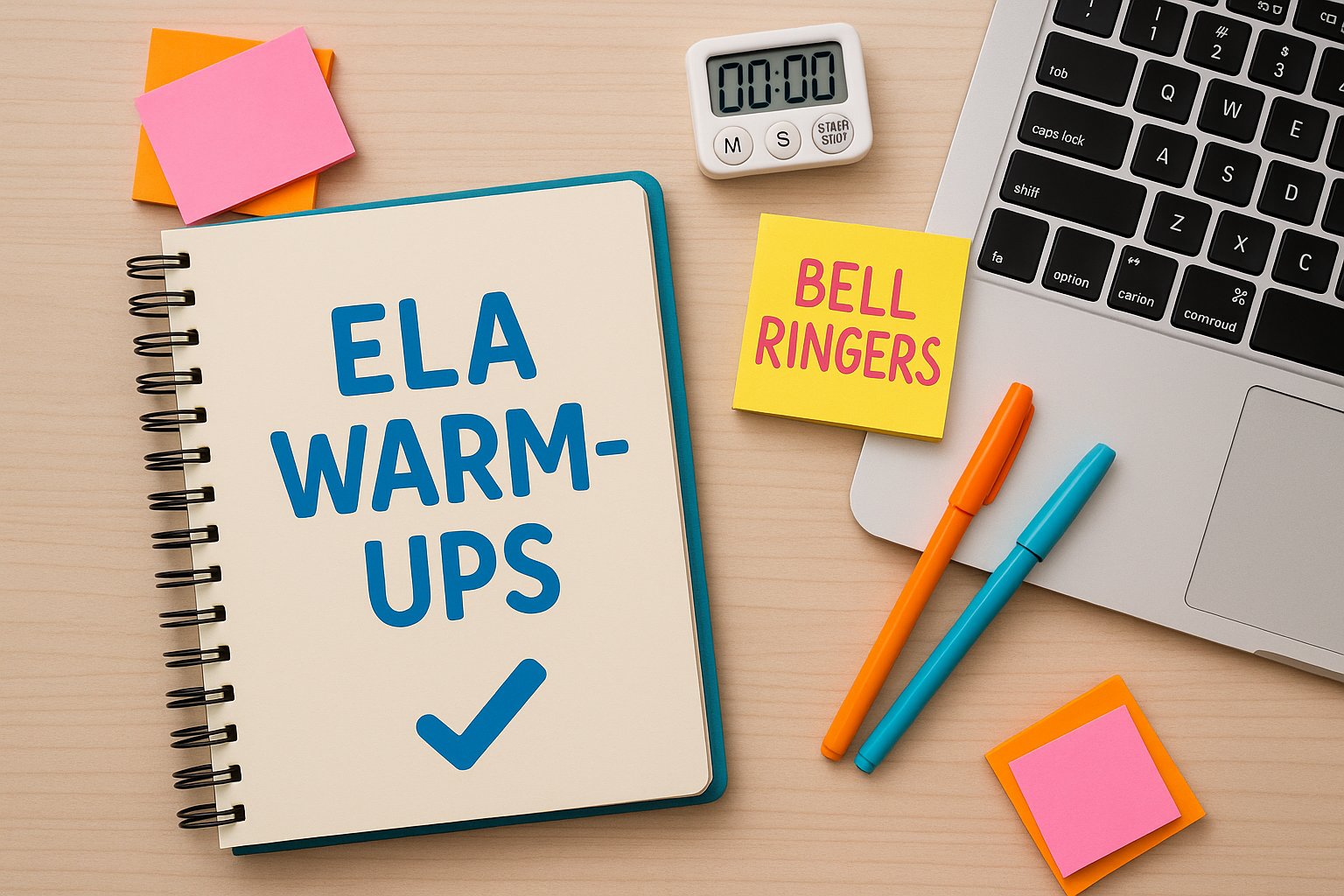Bell Ringers · Routines
15 Bell-Ringer Ideas for Middle School ELA (Fast, No-Prep, Engaging!)

Why Bell Ringers Matter in Middle School
The first five minutes of class are powerful. A strong bell-ringer settles students, signals expectations, and gets brains into “ELA mode.” A weak or inconsistent start often leads to side conversations, slow transitions, and extra behavior redirects.
These 15 fast, no-prep bell-ringer ideas are designed for grades 6–8 and target core skills in reading, writing, vocabulary, grammar, and argument. You can project them, write them on the board, or put them in your LMS for students to complete each day.
1–5: Reading & Comprehension Warm-Ups
1. One-Sentence Summary
Ask students to summarize yesterday’s text in exactly one sentence. Require them to include the who, what, and why or how. This quick routine keeps the previous day’s learning fresh and checks for understanding.
Skills: Determining central idea or theme; summarizing (RI/RL 6–8.2).
2. Quick Recall Question
Project a short question about yesterday’s reading: “What problem is the main character facing?” or “What is the author’s main claim?” Students jot down their answers in their bell-ringer notebook.
3. Theme or Main Idea Check
Share a short paragraph or mini-passage. Ask students to identify either the theme (for fiction) or main idea (for nonfiction) and support it with one detail.
4. Inference Snapshot
Give a one- or two-sentence scenario (“Jamie slammed her locker and walked away without saying goodbye.”). Students write what they can infer and what clues led them to that conclusion.
5. Text Structure ID
Provide a brief paragraph and ask students to identify the text structure (cause/effect, compare/contrast, sequence, problem/solution) and highlight words that gave it away.

6–10: Writing & Grammar Warm-Ups
6. Fix-the-Grammar
Write one intentionally messy sentence on the board with errors in capitalization, punctuation, or grammar. Students rewrite it correctly in their notebooks. Review quickly by asking volunteers to share their corrected versions.
Skills: Conventions of standard English (L.6–8.1, L.6–8.2).
7. Vocabulary Quick-Write
Post one Tier 2 vocabulary word and challenge students to write a complete sentence that shows they understand the meaning. Encourage them to include context clues in their sentence so someone else could figure it out.
8. Sentence Combining
Give students two or three simple sentences: “The dog barked. It was loud. The neighbors woke up.” Students combine them into one strong, clear sentence.
9. Replace the Weak Verb
Project a bland sentence such as, “She went to the door.” Students rewrite it by replacing “went” with a stronger verb and adding a detail: “She stomped to the door,” or “She hurried to the door, heart racing.”
10. Transition Word Boost
Give a short paragraph with a missing transition between two sentences. Students choose the best transition from a short list (however, for example, as a result, meanwhile) and justify their choice.
11–15: Argument, Vocabulary & Creative Warm-Ups
11. Identify the Claim
Share a short paragraph that includes an opinion about a school-appropriate topic (longer lunch, phones in school, year-round school). Students highlight or copy the claim and label it clearly.
Skills: Argument writing, identifying claims (W.6–8.1).
12. Decide the Strongest Evidence
Present a claim and three potential pieces of evidence. Students choose the strongest and briefly explain why it supports the claim better than the others.
13. Context Clues Check
Provide a short passage with one bolded Tier 2 word. Students use context clues to define it, then compare with a dictionary definition as a quick check.
14. 5-Word Story Starter
Give students five random words (“rain,” “backpack,” “whisper,” “orange,” “race”). They must write a strong first sentence of a story using all five words. Share a few aloud for fun.
15. 30-Second Debate
Post a quick, low-stakes prompt such as “Is cereal a soup?” or “Should school start later?” Students choose a side and write a 30-second argument using at least one reason and one example. You can occasionally let students pair-share their arguments.
Making Bell Ringers Work for You
The key to powerful bell ringers is consistency. Use the same format for a week at a time so students know exactly what to expect when they walk in. Over time, these five-minute routines can:
- Reinforce core ELA skills without extra grading.
- Improve classroom management and transitions.
- Give you quick formative data on what students understand.
You can also connect bell ringers to digital practice—like having students play a quick ABZ Learning game after completing a related warm-up. Over time, those first minutes of class become one of your most productive tools for growth.